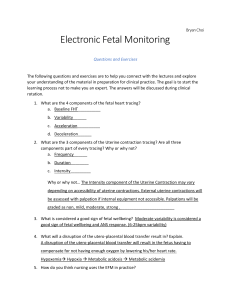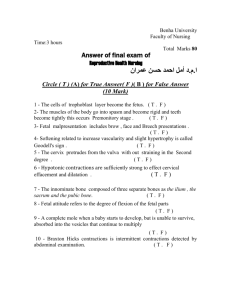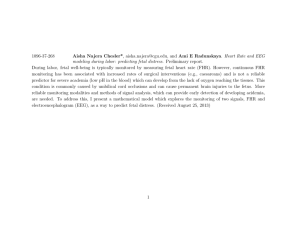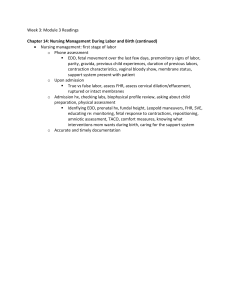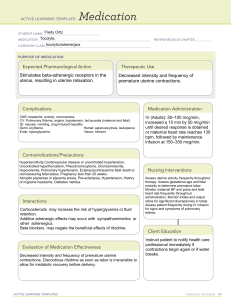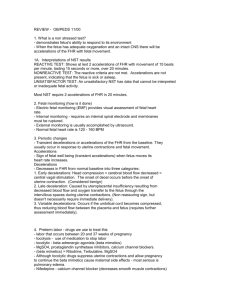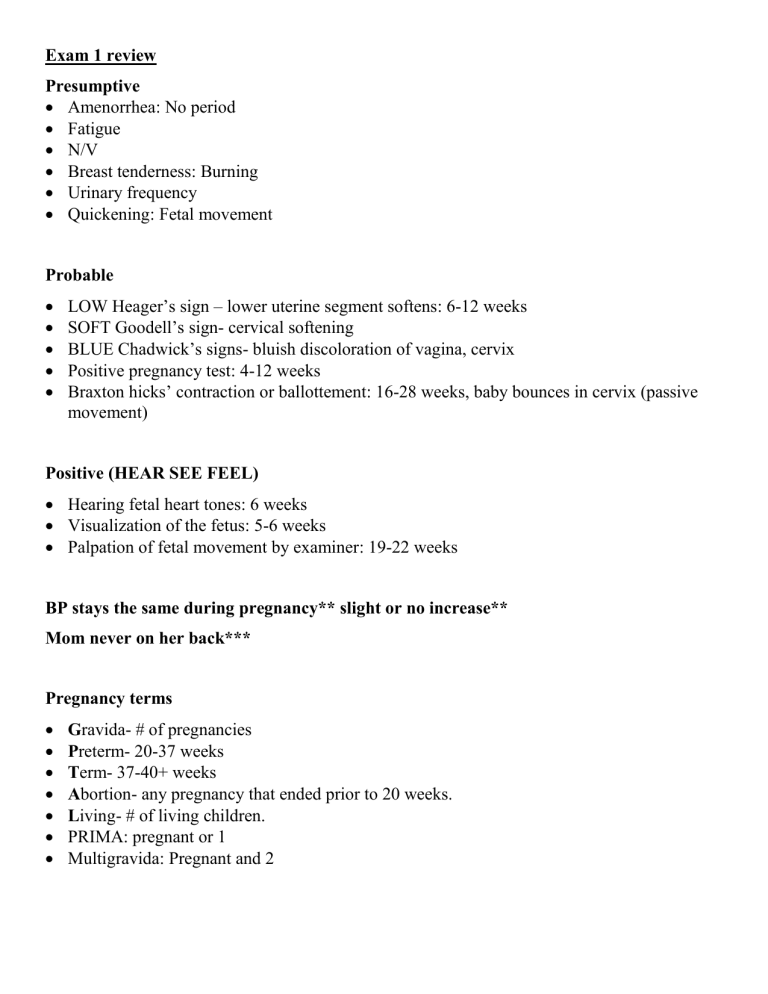
Exam 1 review Presumptive Amenorrhea: No period Fatigue N/V Breast tenderness: Burning Urinary frequency Quickening: Fetal movement Probable LOW Heager’s sign – lower uterine segment softens: 6-12 weeks SOFT Goodell’s sign- cervical softening BLUE Chadwick’s signs- bluish discoloration of vagina, cervix Positive pregnancy test: 4-12 weeks Braxton hicks’ contraction or ballottement: 16-28 weeks, baby bounces in cervix (passive movement) Positive (HEAR SEE FEEL) Hearing fetal heart tones: 6 weeks Visualization of the fetus: 5-6 weeks Palpation of fetal movement by examiner: 19-22 weeks BP stays the same during pregnancy** slight or no increase** Mom never on her back*** Pregnancy terms Gravida- # of pregnancies Preterm- 20-37 weeks Term- 37-40+ weeks Abortion- any pregnancy that ended prior to 20 weeks. Living- # of living children. PRIMA: pregnant or 1 Multigravida: Pregnant and 2 Nutrition Protein: Beans, Nuts Iron needs to double, take with VIT C, empty stomach and not with milk Calcium for babies’ bones: TUMS Neagle’s Rule calculating estimated due date (EDD) 1st day of last menstrual period (LMP) Subtract 3 from month Add 7 to the day and adjust the year. Fetal assessment Fetal heart rate 110-160: First 10-12 weeks Uterine height in cm should equal gestational ag +/-2 Fetal movement: should feel constantly every day after 18 weeks Cardiac changes: Palpations: HR (increases by 15-20) Blood volume increases 40-50% result in physiological anemia. Cardia output increase 30-50% increased risk for blood clot due to increase in clotting factors and decrease in circulation. Possible DVT In low extremities Multiple gestation causes cardiovascular stress Increased risk for clothing due to increased clotting factors Respiratory changes: Slight increase in RR because of HR Increase oxygen requirements to meet maternal and fetal needs. Ligaments of rib cage relax Diaphragm is displaced due to enlarging uterus, chest breathing vs. abdominal breathing Upper respiratory more vascular: Nasal congestion, epistaxis (nosebleed), changes in voice. (Upper respiratory infection) SOB common Vascular resistance Integumentary changes: Linea Nigra: Belly button line Striae Gravidum: stretch marks Palmar Erythema: Red palm Sweating Increased, Increased metabolic rate Vascular Malformation: spider veins Renal Changes Ureters relax Bladder displacement Decreased bladder tone BUN, Creatinine, uric acid Glucose Gastrointestinal changes: Everything slows down N/V increased HCG should subside 1st trimester. Hyperemesis gravidarum: excessive vomiting **complication: IV hydrate Phenergan, home with it also: Diet: High protein low fat- meals, more frequent small meals, bland foods, dairy settles better, eat a popsicle after you throw up** Changes in taste and smell Ptyalism: excessive saliva Pica: food with no nutritional value** PICA ** can cause anemia (ice, clay, starch) Decreases tone and motility in GI tract (reflux and constipation) Flatulence, constipation, hemorrhoid Epulis: Raised nodule on the gums** First trimester labs Hgb: >11 and Hct: >33 (CBC) Blood type and Rh = + or - **RH Rogram administered 28 weeks, book: RH administered to RH negative women to prevent formation of antibodies by destroying fetal RBC’s. (Can lead to hyperbilirubinemia: jaundice) ** RH negative women receive the RH immunoglobin after an amniocentesis Antibody screen Rubella titer (may offer booster after pregnancy) **Rubella & Varicella can cause congenital anomalies** Urinalysis Pap smear: if not last 3 years Screening for HIV and Hep B VDRL and RPR Offer sickle cell Offer cystic fibrosis Gonorrhea/chlamydia: common and curable Platelets low? HEMORRHAGE >100,000 **Group B beta strep culture** First trimester discomforts Breast changes: enlargement, pain, tingling, tenderness* Urinary frequency Fatigue N/V Ptyalism Gingivitis and epulis (gum hypertrophy, bleeding) Nasal stuffiness Leukorrhea (clear or light-colored mucus) ***First Trimester Complications*** Severe constant abdomen pain Vaginal bleeding (saturating the pad in 30min-1 hour) Second trimester discomforts Acne, pigmentation changes (hormonal)* Palmer erythema Pruritus Palpitations Supine hypotension (vena cava syndrome) NEVER flat on back** Rule out hypoglycemia* Faintness, syncope Heartburn Constipation, flatulence Headaches Carpal tunnel syndrome Periodic numbness, tingling of fingers. Round ligament pain Joint pain, backache, pelvic pressure NO NSAIDS or aspirin** Third trimester discomforts Shortness of breath and dyspnea Insomnia Mood swings, increased anxiety Urinary frequency and urgency return Perineal discomfort and pressure Leg cramps Ankle edema Third trimester labs 1 hour glucose test, elevated? 3-hour glucose o If 2 are elevated: indication of Gestational diabetes mellitus o 1 hour is non fasting 3 hour is 8-14 hours? Group B strep vaginal/rectal swab Second and third trimester complications Persistent severe vomiting Sudden discharge of fluid from vagina: Can be preterm rupture of membranes Vaginal bleeding; severe abdominal pain: Miscarriage, Placenta previa, abruptio placentae Chills, fever, burning on urination, diarrhea: infection Severe backache or flank pain: kidney infection/stones or pre-term labor Change in or absence of fetal movement: fetal jeopardy or intrauterine fetal death Uterine contractions: preterm labor Symptoms of preeclampsia: HTN, Visual disturbances (photophobia) swelling of face & fingers, Headache, seizures, and abdominal pain Glycosuria: positive glucose tolerance test (3 hour): Gestational Diabetes Mother is immunocompromised** Anemia Normal value during pregnancy Hbg >11** HCT >33** Occurs in 20% pf pregnant women Associated with increased incidence of miscarriage, preterm labor, preeclampsia, infection, postpartum hemorrhage, and intrauterine growth restriction. Can cause PICA What diet??**: High in Iron: red meats, spinach (GLV), broccoli, dark chocolate, egg, liver, beans, legume, cashews Hypertension Chronic: <20 weeks’ gestation Gestational: after 20 weeks Risks: o Placental abruption o Growth restriction (fetus) o Preterm birth Incompetent cervix: Stays open during pregnancy without contractions Passive and painless dilation of the cervical without labor or contraction of the utterer May occur in late 2nd or early 3rd trimester Related to cervical trauma, excessive cervical dilation, ingestion of DES by a woman’s mother. Management: o Bedrest (temporary) hydration, tocolytics (smooth muscle relaxer) Ibuprofen (NSAID), Pelvic rest o Cerclage may be placed at 11-15 weeks, removed at 37 weeks***: requires sutures o Risk with cerclage: premature rupture of membranes, preterm labor, infection. (May be on antibiotics) o GOAL: Get to 37 weeks HELLP syndrome Can occur with severe preeclampsia (but not everyone), because of the mag sulfate Lab diagnosis: Hepatic Function*** o H – hemolysis o E- elevated o L- liver enzymes o L- low o P- platelets o AST, ALT (4-20) (3-21) R/F: o Acute Renal failure & acute respiratory failure o Hemorrhage o Pulmonary edema o Maternal death o Disseminated cardiovascular coagulation (DIC) o Stroke o Sepsis Placenta previa: Placenta is covering the cervix ***PAINLESS BRIGHT RED*** Low-lying (c): vaginal Partial or marginal (A): cesarean Complete (B): cesarean Painless bright red vaginal bleeding: *will know the dangerous amount to go to ER Never perform vaginal exam on a woman who is bleeding unless you know location of placenta. Can never deliver baby through placenta: cesarean ALWAYS tell doctor you have this** NOTHING IN Pelvic rest: NOTHING IN Possible Bed rest NEED IV ACCESS Abruptio placentae (abruption) ***CONSISTANT RIGID ABD & DARK RED (WINE) **** Premature separation of placenta from implantation site after 20 weeks: Uterine Wall Signs: vaginal bleeding, severe abdominal pain (rigid board-like abdomen) *****, uterine contractions (hypertonus), port wine strained amniotic fluid**** (depends on which part of placenta) ABD TRAUMA can cause this*** Emergency Cesarean** PRIORITY IS MOM** Multiple gestation can cause this Preeclampsia Mild: outpatients until severe o BP 140/90 or greater o Urine dipstick protein > 1+ Severe: Gets worse and worse o BP 160/110 or greater o Urine dipstick protein > 3+ o Persistent or severe headache: even after Tylenol o Blurred vision; photophobia o Epigastric pain: Right upper quadrant o Intrauterine growth restriction of fetus Only cure is delivery: induce her A lot of weight gain is a red flag, can be R/T facial edema or edema in feet Seizure changes is from pre to eclampsia Decreased placental perfusion and organ perfusion Clonus ticks = sicker mom (+3) Decrease stimulation Seizure precautions: Suction, Padded rails, 02 Mom might be combative or confused after a seizure** Can have chronic HTN or cardiovascular disease later in life** R/F: o Family HX or previous preeclampsia o Twins o African American o Obesity o Younger than 19 or older than 46 Labs o Creatinine, BUN (CMP) o AST, ALT (CMP) o Platelets (CBC) o Urine analysis Medications IV Magnesium sulfate with Bolus: CNS depressant, smooth muscle relaxant; used to prevent seizures. Usually on taken for a max of 4 days due to relaxation of the heart muscle. *** Check BP for Baseline before administration*** o Loading dose: 30 minutes stay at bedside for reaction, can become nauseous o Maintenance dose o ANTIDOTE: Calcium Gluconate o Still on mag 24 hours after delivery o FALLS RISK Steroids, Labetalol Assessment: RR (12 or >), LOC, DTR, Urine output (foley, which is assessing the kidney function as well) serum mag levels (4-7mg/dL is normal) **, Check o2 Mag Toxicity: Stop immediately, Loss of LOC, Low B/P, can make the uterus relax too much*, prevent respiratory or cardiac arrest. DC immediately. ** 7+ is toxic Interventions: o Seizure precautions, Foley catheter, falls risk, safety, bedrest, decrease stimulation, monitor FHR, ask about fetal movement o Teach to take B/P at home, weigh herself at home (same time same scale), count kick counts, 10-12 movements over every 2 hours, report worsening symptoms Pregestational diabetes Type 1 or type 2 (more common) Glucose crosses placenta; insulin does not. Fetus produces insulin around 10th week. First trimester (weeks 7-15) prone to hypoglycemia due to metabolic changes related to hormones. Second and third trimester insulin needs may double or quadruple. SELF monitoring should be reviewed at every visit* A1C if for 3 months because RBC last 3 months** : Anemia can falsely increase** Risk factors: o Early pregnancy loss o Macrosomia (infant >4000gms): big baby o Comorbidities (especially hypertensive disorders): preeclampsia o Preterm labor o Polyhydramnios: too much amniotic fluid o More common & serious infections o Postpartum hemorrhage o Increased risk of cesarean delivery. Fetal risk factors: o Unexplained fetal death o Congenital anomalies o Macrosomia o Hypoglycemia o Respiratory distress o Prematurity Gestational diabetes Risk factors: o Obesity o Family history o Age >35 o Comorbidities o Having a previous infant >9lbs at birth Screenings: o 1 hour glucose tolerance test 24-28 weeks o If abnormal followed by 3-hour OGTT: Test before glucose, then at 1 hr, 2 hr and 3 hr: 2 elevated? = Gestation Diabetes Treatment: o First step: dietary modifications (diabetic diet) and exercise ** (uterine contractions can occur during this) ** o Step 2: insulin o Oral antidiabetics not often used because they cross the placenta insulin does not cross the placenta. Complications: can be same as with pregestational diabetes o At greater risk of developing diabetes later in life. (Type 2) * o Cesarean** o Encourage breast feeding** o Birth control (Contraceptives) Preterm labor (Spontaneous) - Most common Spontaneous abortion: Complete cerclage, early pregnancy bleeding Diagnosis based on 3 factors: MUST have all 3 o 20-37 weeks’ gestation o Uterine activity (contractions) o Progressive cervical change (effacement and/or dilation) Risk factors: history of PTL, multiple gestation, 2nd trimester bleeding, African American race, low pre-pregnancy weight, genital tract infections. UNTREATED BACTERIAL VAGINOSIS can cause preterm labor**** Signs: o Painful or painless contractions every 10 minutes for 1 hour or more*** o Lower abdominal cramping o Painful menstrual-like cramps o Dull, intermittent low back pain (below waist): coming and going & bloody show o Suprapubic pain or pressure o Pelvic pressure or heaviness (feels like baby is pushing down) o Changes in character of cervical discharge or amount o Rupture of amniotic membranes “preterm rupture of membranes” o Signs of UTI Treatment: o Lifestyle modifications: decrease in activity, lifting, riding long distances o Pelvic rest, bedrest o Tocolytic medications- (relax smooth muscle) OFF AT TERM **Terbutaline: oral or SC (must take pulse rate, if >120 hold) (Tachycardic) Magnesium sulfate: smooth muscle relaxer but can also decrease chance for Cerebral Palsy in a per term baby** Used if Terbutaline doesn’t work or given for 48 hours already, or if 3-4 cm dilated. *** Indocin Procardia (nifedipine): Headache* Corticosteroid (Betamethasone): Develops premature lungs in preterm baby* Nifedipine and Magnesium given together can cause skeletal muscle blockade (paralyze) the transmission of nerve impulses at the myoneural junction***** Tocolytic Therapy Contradictions: FETUS o More than 37 weeks o Fetal Demise: Still Birth* Contradictions: MOM o Preeclampsia o HTN o Hemorrhage The five P’s Passenger (fetus) Passageway (birth canal) Powers (contractions) Position (mother) Psychologic response Passenger Presentation- part entering pelvic inlet first. o Cephalic (vertex) HEAD** o Breech (buttocks, feet, or both) o Shoulder (scapula) Fetal lie, attitude, and position (all factors that determine presenting part) Fetal lie Relation of long axis (spine) of fetus to long axis (spine of mother Longitudinal/vertical: parallel Transverse: at a right angle Oblique: at an angle. Fetal attitude Fetal head flexed or extended. Typically flexed, chin to chest, allows easy passage through maternal pelvis If extended may not be able to fit through pelvis. Fetal position Relationship of reference point on presenting part (occiput, sacrum mentum) to the four quadrants of the maternal pelvis Denoted by 3 letters: o 1st- location of presenting part (right or left) o 2nd – specific presenting part o 3rd location of presenting part in relation to pelvis (anterior, posterior, or transverse). Fetal position Occiput – back of head*** Mentum- face POST: head to back (A)NTERIOR: head to (A)abdomen Transverse: back to the side of the mom Station Relationship of presenting part to an imaginary line drawn between the maternal ischial spines. Engagement Largest diameter of presenting part Is at level of ischial spines. (=0) ** “+” = closer to delivery*** **test doesn’t state epidural = no epidural** Problems with passageway If mother’s pelvis is not gynecoid shape may not accommodate baby Macrosomia: Big baby Cephalopelvic disproportion (CPD)- baby’s head unable to fit through maternal pelvis. Powers Primary- involuntary contractions. o Effacement- thinning of cervix (0-100%) o Dilation- opening of cervix (0-10cm) Secondary- mothers bearing down or pushing with contractions. Ineffective primary powers: **Mom might be too tired** Amniotomy- puncture hole in amniotic sac; fetal head applies pressure to cervix: breaks water* Priority assessment – FHR; also assess amount, color, odor. Augmentation- IV Pitocin; increase amount until contractions are every 2-3 mins & moderate intensity. Fetal movement 10 kicks in 2 hours Eat before counting Concentrate Induction of labor: **Cervix must be soft to efface and dilate** Chemical or mechanical initiation of uterine contractions before their spontaneous onset. Chemical: prostaglandins to ripen (soften) cervix may stimulate contraction (Cytotec, cervidil, prepidil) Pitocin: Causes contractions** Mechanical o Foley catheter balloon o Laminaria o Stripping of membranes: Breaking the water manually o DON’T want a firm Cervix** Indicated if continuing the pregnancy can be dangerous to mom or baby Rupture the membranes (amniotomy) or starting oxytocin (Pitocin) Woman must know the risks, benefits, and alternatives as part of the consent Maternal position Change positions frequently- helps to relieve fatigue, promotes comfort: Improves circulation and helps baby maneuver thru the cervix*** Positions for second stage of labor (pushing) dependent on condition of mom and baby and PHCP preference. Mechanism of labor Seven cardinal movement: o Engagement o Descent o Flexion o Internal rotation o Extension o External rotation o Expulsion Rupture of membranes Methods to determine ROM o Nitrazine paper o Fern test o Amnisure swab Increased risk of infection if >24 hours What do we assess? Priority FHR**** Monitor temperature q2 hours **Amniotic fluid: Should be clear and odorless (maybe meconium stained) ** o Polyhydramnios: too much fluid o Oligohydramnios: too little fluid o Meconium stained: 1st stool before birth Place infant at risk for meconium aspiration Requires skilled neonate CPR at bedside Suction meconium below cords before their 1st breath The FHR should be assessed immediately to detect any changes, Tachycardia is common. Chorioamnionitis: Bacterial infection of the amniotic cavity o S/S: o Maternal fever o Fetal tachycardia o Uterine tenderness o Amniotic fluid with an odor (foul smell) Phases and stages of labor Stage 1: 0-10 cm o Phase 1: Latent – Dilate 0-3 cm o Phase 2: Active – Dilate 4-7 cm o Phase 3: Transition – Dilate 8-10 cm Stage 2: From complete dilation and effacement to delivery of the baby Stage 3: From delivery of the baby to the delivery of the placenta Stage 4: The first hour after delivery Monitoring TOCO: measures pressure changes with uterine contractions Duration: how long it lasts Stage 1: latent phase: Dilates 0-5 cms Contractions: 5-30 min apart, 30-40 seconds long, mild intensity. Promote comfort, ice chips, empty bladder q2h, encourage breathing and relaxation. Assess FHR, VS q4h (unless ROM then q2h) and emotion of mom* Usually, happy, excited, nervous. Stage 1: Active phase: active pushing and urges to bear down Dilates 6-10 cm Contractions: 1.5-5 min apart, 40-90 seconds long, moderate to strong intensity Becomes more labor focused, may ask for and receive pain medications. Promote comfort, position changes, ice chips, assist with breathing techniques and relaxation, empty bladder frequently (full bladder can inhibit fetal descent) Monitor FHR, VS Tachycardia can be associated with infection** Assess frequency, duration, intensity, and resting tone** Stage 1: transition phase Dilates: 8-10 cm Contractions: 2-3 min apart, 45-90 seconds long, strong and intense. May feel rectal pressure and urge to push. (CANNOT PUSH UNTIL 10 CM, IF SHE PUSHES BEFORE THIS THE CERVIX MAY SWELL, A SWOLLEN CERVIX DOES NOT DILATE!): can lacerate or tear: Risk for Hemorrhage*** Common to have N/V, mood very intense, irritable Offer ice chips, cool wash cloth, lots of encouragement, keep bladder empty, encourage deep breaths to avoid hyperventilating. May note early decelerations on fetal monitor strips. Pain management in labor (NO IV DRUGS DURING TRANSITION PHASE) Epidural is a regional anesthesia that blocks pain in a particular region of the body. The goal is to give pain relief and not anesthesia. Epidural blocks the nerve impulses from the lower spinal segments, resulting in decreased sensation in the lower half of the body. (STERILE) This will not remove the pressure sensations when the fetus descends the pelvis** o Side effects: Numbness and Tingling below waist (no intervention) o Hypotension: Bolus and oxygen. FHR can drop so reposition** o Low platelets: below 100,000 Anesthesia will decide to proceed or not Drug class called local anesthetics. Spinal= Immediate Epidural= 10 minutes Check BP** SPINAL TATTOO? Don’t initiate** IV narcotics: Start with Nitrous Oxide Demerol Stadol Assess dilation before administration Respiratory distress in fetus NARCAN Don’t give to a drug dependent mom (Suboxone) ASSESS FHR, RR, BP BECAUSE OF EFFECT ON 02 BEFORE ADMINISTRATION** General Anesthesia can cause: Abruption Prolapsed cord Fetal HR drops (decelerations) Emergency Delivery or a C-section Crosses placenta (resp distress in fetus) Clotting problems (PT, PTT) Low platelets Side effects of an epidural Low BP Loss of bladder control Itchy skin Feeling sick Inadequate pain relief Headache Slow breathing Temporary nerve damage Infection Permanent nerve damage Check PT and PTT Stage 2: delivery of infant Begins when 10 cm dilated, ends with deliver of infant: 100% effacement Contractions may space out Can last up to 2 hours Require a lot of energy May want to give up, needs lots of encouragement and support. May feel burning when fetal reaches perineum (+4 station) Crowning** Encourage mom because she can’t see progress** Cesarean Section Delivery of infant through abdominal incision o Low transverse (bikini cut) (invasive) o Vertical- always a repeat c-section (invasive) o History of uterine rupture must always have repeat c section Primary or elective: preserves life and health of mom or baby Trial of labor after cesarean (TOLAC) Vaginal birth after a cesarean (VBAC): 3+ sections, or vertical decisions always repeat Breach Position** Anesthesia Foley Have them up walking as soon as possible* Check mom’s emotional response and promote bonding and comfort for mom and family Watch baby safety may be drowsy from the procedure. Stage 3: delivery of placenta begins with delivery of infant, ends with delivery of placenta spontaneous or manual: Spontaneous: 5 Minutes separation noted by firmly contracted uterus, sudden gush of dark blood (introitus) and lengthening of umbilical cord examined to ensure it is intact fragment of placenta left in uterus can result in postpartum hemorrhage and infection fetal side (shiny Shultz), maternal side (dirty Duncan) cultural considerations. Vaginal Fullness Stage 4: immediate recovery first 1-4 hours after delivery mother recovering from birth process, infant adapting to extrauterine life VS monitored q15 min first hour, q30 min second hours, temp at beginning and end unless abnormal Assess fundus, lochia, perineum, incision site with cesarean section, keep bladder empty, assess for return of sensation and movement if pat has epidural. Placenta Care Assess for bonding, baby adaption to the new world** At delivery: FUNDUS AT UMBILLICUS** Cultural considerations Discuss any concerns or requests related to culture. Want to ensure best experience possible. Considerations: o Some women may be very stoic during labor other very vocal. o Fathers may or may not be present. o May prefer alternate positions for deliver such as squatting. o May prefer or request female caregiver: If available* Contractions Duration is from the beginning of a contraction to the end of the same contraction. Frequency is from the begging of one contraction to the beginning of the next contraction. Intensity is the strength of the contraction. VEAL CHOP V- variable decel C- cord compression E- early decel H- head compression A- Acceleration O- OKAY, Oxygenated L- late decel P- Placental Insufficiency Interventions: (must take action) put on oxygen. Nonrebreather* turn off Pitocin stops contractions turn to side: increases perfusion increase IV fluids: BOLUS Call PCP. Actions to take for prolapsed cord: Loop of umbilical caught between vaginal wall and baby’s head Rapid decent in fetal HR** Prepare for emergency c section. Bradycardia and Variable decelerations can indicate this** Forceps: Because FHR can decrease. Assess, record and report before and after this application GET PRESSURE OFF CORD to restore blood flow** Assess FHR closely and for several minutes after ROM to determine well-being of fetus & document Rupture of membranes can cause this* Wrap cord in normal saline in an acute setting Post term Labor -More than 42 weeks* Mom: Dysfunctional labor Macrosomia injury Hemorrhage Infection Fetus: Abnormal growth Oligohydramnios MD normally induces at 41 weeks Dysfunctional Labor (Dystocia) -Long, Difficult, or abnormal labor Ineffective contractions or maternal bearing down efforts Different pelvic structures: abnormal maternal bony pelvis or soft tissues abnormalities or the reproductive tract (passage) Fetal causes: abnormalities of presentation, position. Or development Maternal position, fatigue, dehydration Shoulder Dystocia: Legs back FAR and head back FAR (McRoberts Maneuver) o Can cause brachial plexus** o The anterior shoulder can’t pass o Shortens the birth canal Moms who are at increased risk for: Over wt. Short suture Infertility Uterine abnormalities Macrosomia Too much Pitocin (oxytocin) Precipitous Labor: Less than 3 hours Placental abruption: hypertension? trauma? cocaine? Complications: Fetus: Fetal hypoxia Changes in fetal HR Unnecessary CS for FHR patterns Mom: Pain Abruption Uterine rupture Postpartum hemorrhage Infection Peri-rectal injury Obesity Increasingly serious problem for pregnant women Likely to begin pregnancy with pre-existing conditions HTN Diabetes Increased r/f of postdate pregnancy and complications Nursing care has many challenges Oxytocin: HIGH ALERT Hormone-posterior pituitary gland; stimulate contractions Induce or augment slow labor r/t poor uterine contractions HIGH alert 1mu/min: 1 ml/hr. Placental abruption Uterine rupture Unnecessary c-section (she will keep bleeding, NOT good) Post-partum hemorrhage (uterus isn’t clamping down) Infection Fetal hypoxemia acidemia (PH becomes more acidic) (they take ABG’s blood gases) Oxytocin (Pitocin) Augmentation of labor requires careful monitoring of fetus Implement management of hypnotic uterine dysfunction Stimulation contractions/labor unsatisfactory progress Oxytocin infusions or Amniotomy (rupture of membranes) Contradictions: Unfavorable fetal position Contraindication of a vaginal delivery (Placenta previa, active herpes, macrosomia, fetal distress, early preterm labor) Maternal Oliguria (little output): Notify MD (less than 30 ML an hour) Preeclampsia? Kidney problems? Don’t shut off Pitocin, Notify MD FIRST Forceps -Maternal indications: prolonged second stage of labor -Fetal indications: Abnormal FHR tracing Certain abnormal presentations/arrest of rotation Delivery of head in breach presentation Vacuum Assisted birth Attachment of vacuum cup to fetal head using negative pressure to assist birth of head Prerequisites: Completely dilated cervix Vertex presentation/engaged head Ruptured membranes No suspicion of CPD (pelvic disorder) Rupture of Uterus Multiple c-sections because of the scar Overdistended uterus: multifetal or macrosomia Augmented or induced labor with intense contractions No previous vaginal births, Uterine trauma, Forceps delivery, Infection, Short interpregnancy interval S/S o Abnormal FHR and loss of contraction tracing o Tetany (muscle spasms) of uterine muscle o Loss of fetal station o Abdominal pain/shock LABS: Normal Values PTT: 60-70 seconds PT: 12-14 seconds BUN 10-20 Creatinine: 0.5-1.1 AST: 4-20 Units ALT: 3-21 Units Magnesium: 4-7 meq



